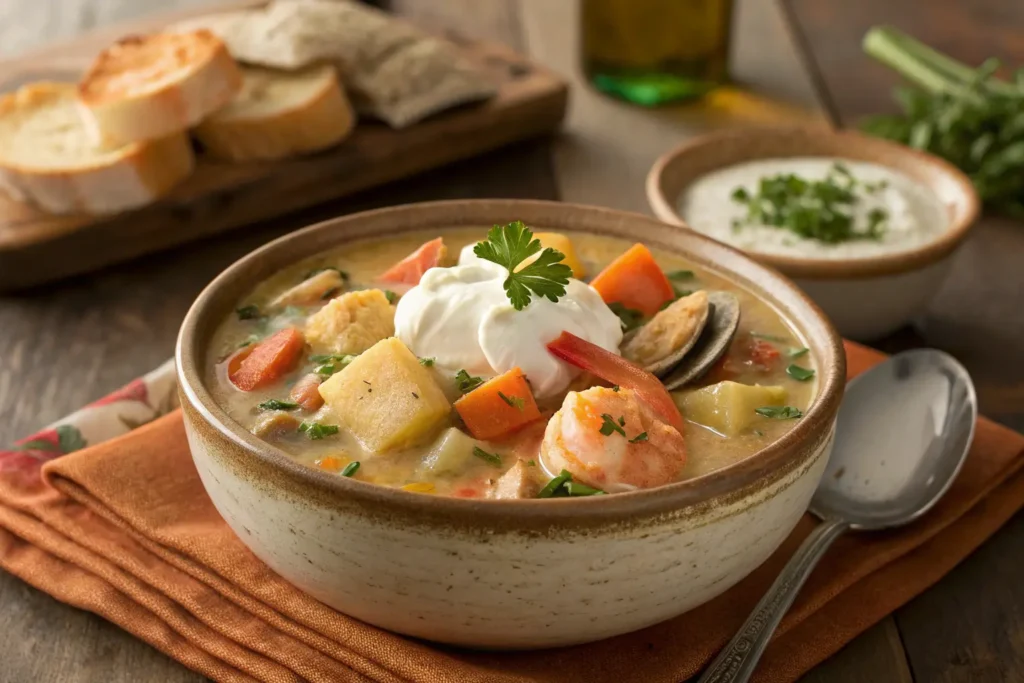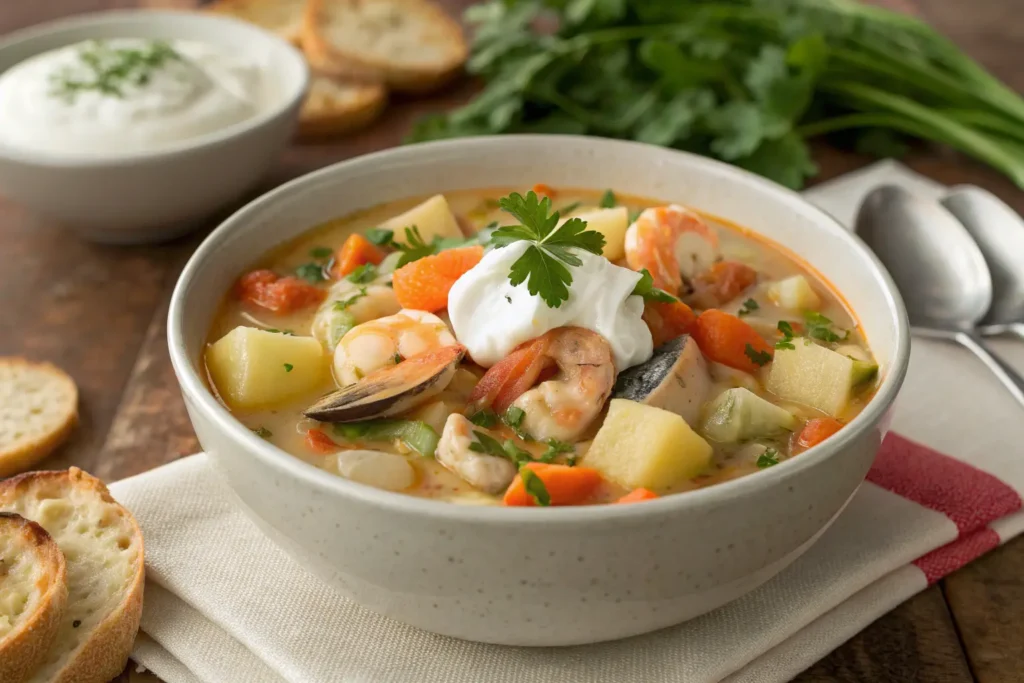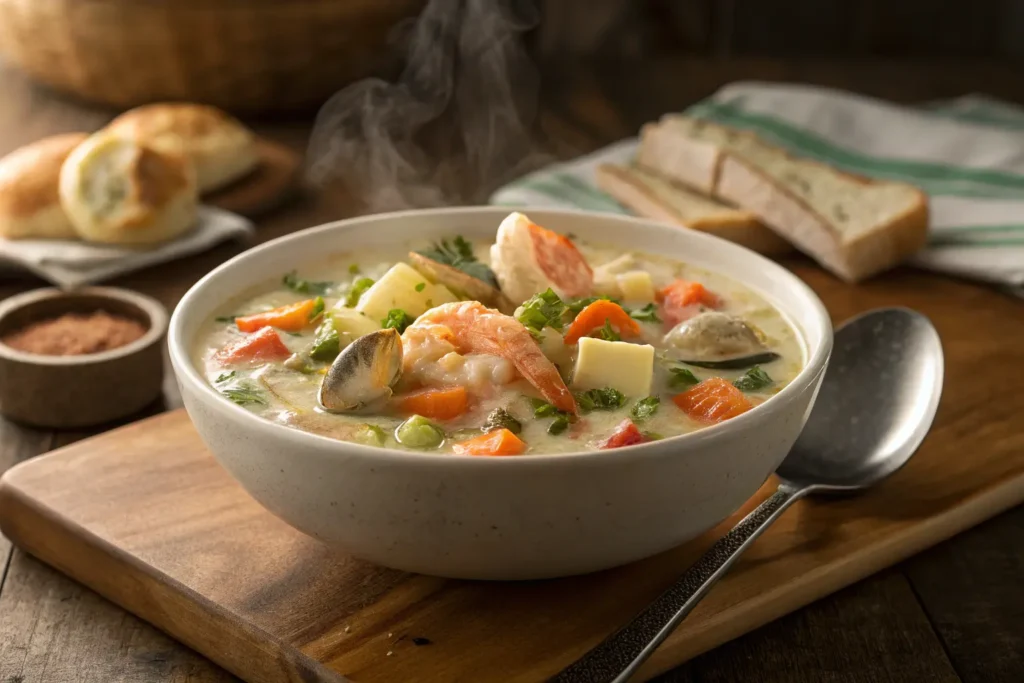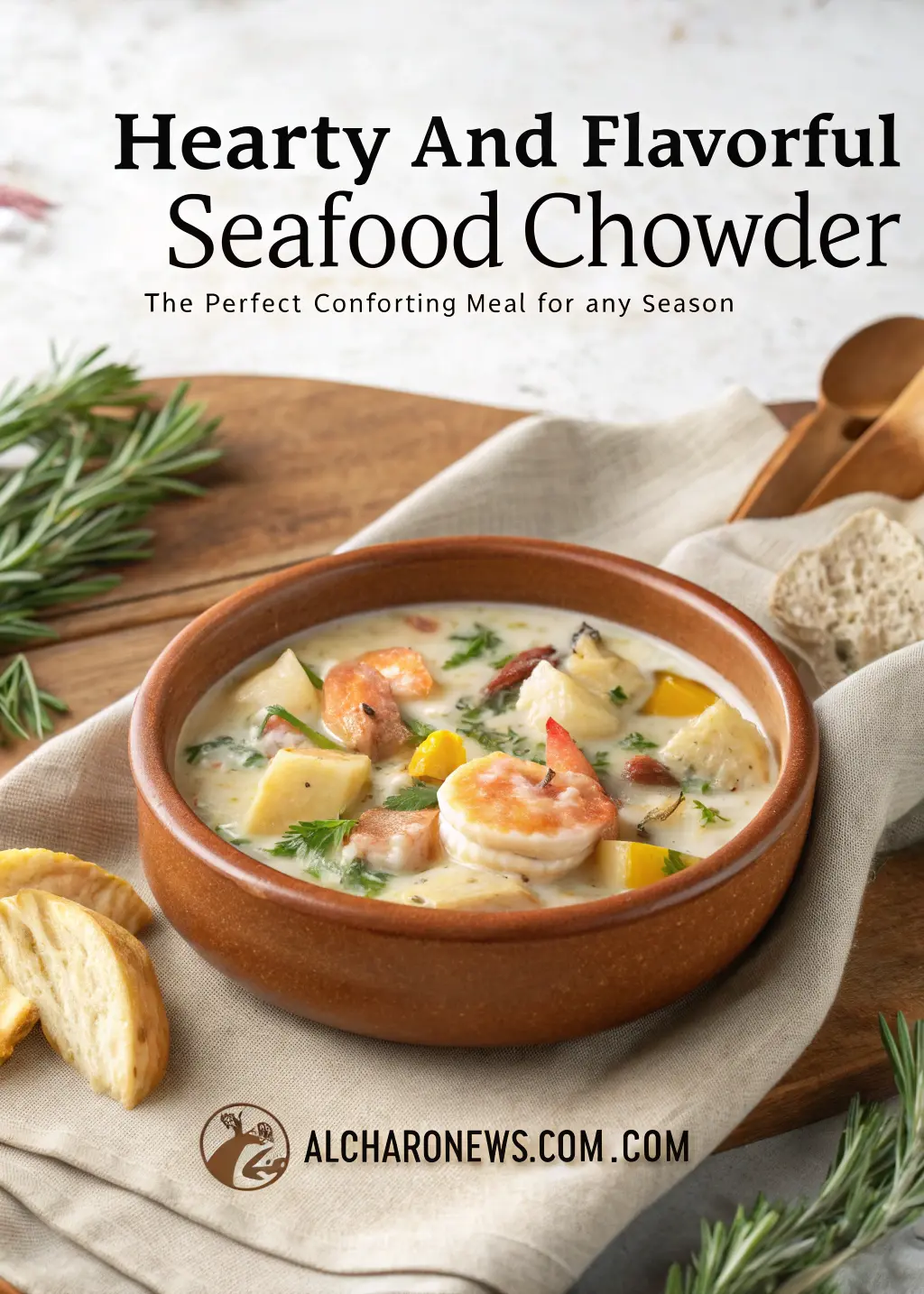Picture yourself wrapped in your favorite throw blanket, rain tapping rhythmically against windows as winds howl outside. Now add something truly magical to this scene – a steaming bowl of creamy seafood chowder warming your hands. That first spoonful delivers wave after wave of delicious flavors – tender chunks of seafood mingling with velvety broth and fragrant herbs dancing across your taste buds. Beyond mere nourishment, a properly crafted seafood chowder represents connection to coastal traditions, embodying that rare culinary achievement that satisfies deeply regardless of outdoor temperatures or calendar dates.
Table of contents

The Rich History of Seafood Chowder
From Humble Origins to Beloved Classic
Tracing back through culinary history reveals fascinating origins for the dish you now cherish. The term “chowder” stems from the French word “chaudière” (meaning cauldron), pointing to its earliest preparation methods. Coastal fishing communities across Northern Europe and eventually North America developed these hearty, sustaining meals out of necessity.
Fishermen sought simple one-pot creations that utilized their daily catch alongside preserved ingredients during long voyages. What began as practical sustenance gradually evolved into regional specialties, with techniques passed between generations. Each coastal region developed unique interpretations – some featuring milk bases, others focused on clear broths or tomato foundations – creating distinct expressions of this fundamentally adaptable concept.
Why Seafood Chowder Remains Timeless
Few dishes demonstrate such remarkable staying power across centuries and cultures. This persistence stems from several factors working in harmony. First, chowder celebrates coastal abundance while accommodating seasonal availability. Second, its basic components provide impressive nutritional balance – protein-rich seafood combines with vegetables and complex carbohydrates to create deeply satisfying meals. Finally, chowder bridges rustic and refined dining experiences, equally appropriate for casual family gatherings or upscale dinner parties.
The blend of creamy richness with briny ocean flavors creates something greater than individual components could achieve alone. This magical alchemy explains why seafood chowder recipes appear in treasured family cookbooks and prestigious restaurant menus alike.
Essential Ingredients for an Unforgettable Seafood Chowder
The Seafood Foundation
Selecting the right combination of ocean treasures transforms ordinary chowder into extraordinary culinary experiences. Consider these options for your next creation:
| Seafood Options | Flavor Profile | Best Cooking Technique |
|---|---|---|
| Clams | Briny, sweet | Add last, cook just until opened |
| Shrimp | Sweet, delicate | Add near end of cooking to prevent toughening |
| Cod | Mild, flaky | Add midway through, breaks apart beautifully |
| Salmon | Rich, buttery | Add in larger chunks to maintain texture |
| Scallops | Sweet, tender | Quick sear before adding or add in last few minutes |
| Crab | Sweet, delicate | Add pre-cooked meat at the end |
| Lobster | Sweet, luxurious | Add pre-cooked meat at the end |
Remember that freshness matters tremendously when working with seafood. Speak with trusted fishmongers about recent deliveries, and whenever possible, use seafood within 24 hours of purchase. Those unable to access truly fresh options should consider high-quality frozen alternatives, which often preserve ocean flavors better than seafood that’s been sitting unfrozen for extended periods.
The Aromatic Base
Every memorable seafood chowder builds from a foundation of aromatic vegetables that provide depth and complexity:
| Ingredient | Purpose | Preparation Tip |
|---|---|---|
| Onions | Foundation flavor | Dice finely, sweat until translucent |
| Celery | Adds complexity | Cut uniformly for even cooking |
| Carrots | Natural sweetness | Dice small for quicker cooking |
| Garlic | Aromatic depth | Mince or crush just before adding |
| Leeks | Subtle onion flavor | Clean thoroughly to remove grit |
| Fresh herbs | Brightness | Add heartier herbs early, delicate ones at the end |
Taking time with this foundational step pays enormous dividends in your final creation. Properly sweating aromatics releases essential oils that infuse every spoonful with complex flavors impossible to add later. Consider spending 15-20 minutes developing this base – patience here distinguishes exceptional chowders from merely adequate ones.
The Perfect Chowder Base
Your liquid foundation creates the canvas upon which other flavors build. Traditional New England-style chowders rely on dairy richness through heavy cream or half-and-half. Southern coastal variations might incorporate buttermilk for subtle tanginess. For creamier textures, consider starting with a roux (equal parts butter and flour cooked together) before adding liquid.
Fish stock provides ideal foundation, though clam juice works wonderfully as well. Short on time? Quality boxed seafood stock can substitute, enhanced with bottle clam juice for authentic ocean essence. Whichever direction you choose, remember that proper seasoning matters tremendously – taste frequently and adjust accordingly.
Mastering Seafood Chowder Techniques
Building Layers of Flavor
Creating truly exceptional seafood chowder requires understanding how flavors develop throughout cooking processes:
- Begin by rendering small pieces of salt pork or bacon until they release flavorful fat – this creates the foundation upon which other flavors build
- Add aromatic vegetables to this fat, cooking slowly until they soften without browning
- Deglaze with dry white wine or vermouth, scraping up flavorful bits from pot bottom
- Incorporate stock and potatoes, simmering until vegetables become tender
- Add seafood in proper sequence – firmer varieties first, delicate options last
Throughout this process, taste frequently and adjust seasonings. Remember that cold ingredients mute flavors temporarily – chowder that tastes properly seasoned while hot may need additional salt once chilled.

Common Mistakes to Avoid
Even experienced cooks occasionally stumble when preparing seafood chowder. Watch for these potential pitfalls:
- Overcooking seafood creates rubbery, unpleasant textures – add delicate varieties only during final minutes
- Insufficient salt makes flavors taste flat – oceanic foods generally require proper seasoning
- Adding dairy too early or boiling after addition causes curdling – incorporate off heat or at bare simmer
- Rushing development of base flavors produces one-dimensional results – give aromatics proper time
Take special care with heat management throughout preparation. Gentle cooking preserves delicate flavors while allowing ingredients to harmonize beautifully.
Regional Seafood Chowder Variations Worth Exploring
Coastal communities across North America have developed distinctive chowder traditions reflecting local ingredients and cultural influences. These regional expressions showcase chowder’s remarkable adaptability.
New England Clam Chowder
Perhaps America’s most famous chowder variation, New England-style features rich, creamy base punctuated with tender clams, potatoes, and subtle herbaceous notes. Salt pork or bacon provides savory foundation, while cracked black pepper offers gentle heat. Traditionalists insist upon common crackers served alongside, though oyster crackers have become widely accepted alternatives.
Digging deeper into New England traditions reveals fascinating micro-regional differences. Maine chowders often feature haddock alongside clams, while Connecticut versions might incorporate whisper-thin slices of parsnip for subtle sweetness.
Manhattan Seafood Chowder
Breaking dramatically from creamy traditions, Manhattan-style chowder features bright tomato base filled with abundant vegetables. This preparation sparked legendary “chowder wars” between New England purists and Manhattan innovators during the early 20th century. Rhode Island even contemplated legislation banning tomatoes from chowder entirely!
This controversy aside, Manhattan seafood chowder offers refreshing alternative emphasizing clarity and vegetable brightness. Bell peppers, celery, carrots and onions provide substantial body, while judicious herbs and spices (particularly thyme and bay leaf) create aromatic complexity.
Pacific Northwest Salmon Chowder
The magnificent salmon runs of America’s northwest inspired distinctive chowder traditions celebrating this remarkable fish. Typically featuring chunks of wild-caught salmon, these preparations often incorporate local ingredients like wild mushrooms, fresh dill, and occasionally tiny spots of brightness from fresh corn kernels.
Indigenous cooking techniques influence many regional preparations, with some incorporating traditional preservation methods or smoking techniques that intensify salmon’s natural richness. Lighter cream applications allow the distinctive flavor profile of wild salmon to shine prominently.
Seasonal Adaptations for Year-Round Enjoyment
Summer Seafood Chowder
Warm weather needn’t mean abandoning your chowder cravings. Summer variations lighten traditional approaches through several thoughtful adjustments:
- Replace some cream with court bouillon or fish fumet for lighter body
- Incorporate seasonal vegetables like sweet corn, zucchini or cherry tomatoes
- Brighten with abundant fresh herbs – particularly dill, chives and Italian parsley
- Serve slightly cooler than winter variations, perhaps with cold white wine alongside
These adaptations maintain chowder’s soulful comfort while acknowledging seasonal shifts. Consider serving summer variations as starter courses rather than main attractions.
Winter Comfort Bowl
Cold weather calls for deeper comfort, which winter chowder variations deliver magnificently:
- Increase proportion of root vegetables like parsnips and turnips alongside potatoes
- Incorporate warming spices like white pepper, savory or subtle hints of mace
- Serve with hearty, rustic bread – preferably warmed for optimal dining pleasure
- Consider finishing with drizzle of high-quality olive oil or tiny pat of compound butter
Winter variations benefit tremendously from unhurried preparation. Allow these robust interpretations to simmer gently, giving flavors opportunity to meld harmoniously before serving alongside crackling fires.
The Ultimate Seafood Chowder Recipe
Ready to create your own magnificent seafood chowder? This balanced recipe provides excellent starting point for personal exploration:
Ingredients
| Base Ingredients | Amount | Notes |
|---|---|---|
| Bacon | 4 slices | Diced |
| Butter | 2 tbsp | Unsalted |
| Onion | 1 large | Finely diced |
| Celery | 2 stalks | Diced |
| Garlic | 3 cloves | Minced |
| All-purpose flour | 1/4 cup | For thickening |
| Fish stock | 4 cups | Homemade or quality store-bought |
| Potatoes | 1 lb | Yukon Gold, diced |
| Bay leaves | 2 | Fresh if possible |
| Thyme | 1 tsp | Fresh, minced |
| Seafood Components | Amount | Notes |
|---|---|---|
| Cod or haddock | 1 lb | Cut into 1-inch pieces |
| Shrimp | 1/2 lb | Peeled and deveined |
| Sea scallops | 1/2 lb | Halved if large |
| Clams | 1 dozen | Scrubbed and soaked |
| Heavy cream | 1 cup | Room temperature |
| Half-and-half | 1 cup | Room temperature |
Begin by rendering bacon in heavy-bottomed Dutch oven until crisp. Remove bacon pieces but reserve fat. Add butter to rendered fat, then sauté onions and celery until translucent – approximately 5-7 minutes. Add garlic during final minute, cooking just until fragrant.
Sprinkle flour over vegetables, stirring constantly for 2-3 minutes to cook away raw flour taste. Gradually add fish stock, whisking continuously to prevent lumps. Add potatoes, bay leaves, and thyme, simmering until potatoes become fork-tender.
Add firmer seafood (cod/haddock) first, cooking 2-3 minutes before incorporating shrimp, scallops, and clams. Cover and simmer just until clams open – typically 4-5 minutes. Remove from heat before stirring in room-temperature dairy components. Allow chowder to rest 15 minutes before serving, garnished with reserved bacon and fresh herbs.
Serving and Pairing Your Seafood Chowder
Perfect Accompaniments
Complete your chowder experience with thoughtfully selected accompaniments:
- Crusty sourdough bread or traditional oyster crackers provide textural contrast
- Fresh herb garnishes – particularly chives, dill or parsley – add visual appeal and flavor brightness
- Lemon wedges offered alongside allow guests to adjust acidity to personal preference
- Small ramekins of hot sauce accommodate those who appreciate spicy elements
Beverage Pairings
Complement your creation with beverages that enhance rather than overwhelm delicate seafood flavors:
- White wines like unoaked Chardonnay or crisp Sauvignon Blanc mirror coastal origins
- Lighter beers – particularly pilsners or wheat varieties – refresh palates between rich spoonfuls
- For non-alcoholic options, sparkling water with lemon or lime wedges provides palate-cleansing effervescence

Conclusion: Why Seafood Chowder Deserves a Place in Your Recipe Collection
Few dishes offer such remarkable versatility while delivering consistent comfort. Seafood chowder bridges seasons, accommodates ingredient availability, and satisfies diverse preferences – all while connecting you to rich coastal traditions. Whether preparing quick weeknight dinner or creating centerpiece for special gathering, mastering seafood chowder fundamentals provides lifelong culinary asset.
The techniques learned through chowder mastery transfer beautifully to countless other culinary endeavors. Understanding proper seasoning development, seafood cooking techniques, and dairy incorporation builds confidence applicable throughout your cooking journey. Perhaps most importantly, creating exceptional seafood chowder establishes traditions worth passing forward – cementing your culinary legacy for generations to come.
Why not begin your chowder journey today? Start with simple preparation using readily available ingredients, then gradually explore regional variations and seasonal adaptations. Share your creations with loved ones, gathering feedback and adjusting techniques accordingly. Through this delicious exploration, you’ll discover why seafood chowder has endured as beloved comfort food for centuries – and why it deserves permanent place in your culinary repertoire.
FAQ: Everything You Need to Know About Seafood Chowder
What’s the difference between seafood chowder and clam chowder?
While clam chowder focuses exclusively on clams as the primary seafood component, seafood chowder incorporates varied ocean treasures – potentially including fish, shrimp, scallops and sometimes clams alongside other ingredients. This diversity creates more complex flavor profiles and textural variations compared to single-focus clam preparations.
Can I make seafood chowder ahead of time?
Absolutely! Many chefs maintain that seafood chowder actually improves after resting overnight, as flavors meld beautifully during refrigeration. For best results, prepare base through potato-cooking stage, then refrigerate. When ready to serve, reheat base gently before adding seafood components and finishing with dairy elements. This approach prevents overcooking delicate seafood while still allowing flavor development.
What’s the best way to thicken seafood chowder?
Traditional thickening relies on roux (cooked flour and fat mixture) for silky consistency. Alternative approaches include utilizing natural potato starch released during cooking, adding cornstarch slurry (for gluten-free preparations), or simply reducing liquid through extended simmering. Whichever method you choose, remember that chowder continues thickening as it cools.
Is seafood chowder gluten-free?
Traditional seafood chowder typically contains flour for thickening, making it unsuitable for those requiring gluten-free options. However, simple substitutions create excellent gluten-free alternatives. Replace flour with cornstarch, rice flour, or gluten-free all-purpose blend. Additionally, ensure any packaged stocks or flavor enhancers meet gluten-free requirements.
Can seafood chowder be frozen?
While possible to freeze seafood chowder, texture often suffers upon thawing – particularly with cream-based versions that may separate during freezing. For best results when preparing ahead for freezing, consider making base without seafood or dairy components. Freeze this foundation, then add fresh seafood and dairy when reheating for serving. This approach preserves textural integrity while still providing convenience.
What’s the best seafood to use in homemade seafood chowder?
Optimal seafood selection balances flavor, texture and cooking properties. Firm white fish like cod, haddock or halibut provide excellent foundation. Shellfish including clams, mussels or oysters contribute distinctive briny elements. Crustaceans like shrimp, lobster or crab add luxurious dimension. Focus on freshness above all else – quality ingredients transform good chowder into truly exceptional experience.
How can I make a lighter version of seafood chowder?
Creating lighter seafood chowder involves thoughtful substitutions without sacrificing character. Replace heavy cream with half-and-half, milk, or even part seafood stock. Increase proportion of vegetables while decreasing potato content. Consider clear-broth base instead of traditional creamy foundation. These modifications maintain essential chowder character while reducing caloric content significantly.
Have you given our recipe a try?
There are no reviews yet. Be the first one to write one.

